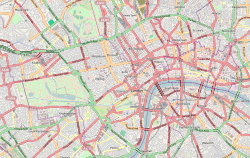Royal National Theatre

The National Theatre from Waterloo Bridge
|
|
|
Location within Central London
|
|
| Address |
South Bank London, SE1 United Kingdom |
|---|---|
| Coordinates | 51°30′26″N 0°06′51″W / 51.5071°N 0.1141°W |
| Public transit |
|
| Designation | Grade II* |
| Type | National theatre |
| Capacity | Olivier Theatre: 1,160 seats Lyttelton Theatre: 890 seats Dorfman Theatre: 400 seats |
| Production | War Horse, One Man, Two Guvnors |
| Construction | |
| Opened | 1976 |
| Architect | Denys Lasdun |
| Website | |
| nationaltheatre.org.uk | |
The Royal National Theatre (generally known as the National Theatre) in London is one of the United Kingdom's three most prominent publicly funded performing arts venues, alongside the Royal Shakespeare Company and the Royal Opera House. Internationally, it is known as the National Theatre of Great Britain.
From its foundation in 1963 until 1976, the company was based at the Old Vic theatre in Waterloo. The current building is located next to the Thames in the South Bank area of central London. In addition to performances at the National Theatre building, the National Theatre company tours productions at theatres across the United Kingdom.
Since 1988, the theatre has been permitted to call itself the Royal National Theatre, but the full title is rarely used. The theatre presents a varied programme, including Shakespeare and other international classic drama; and new plays by contemporary playwrights. Each auditorium in the theatre can run up to three shows in repertoire, thus further widening the number of plays which can be put on during any one season.
In June 2009, the theatre began National Theatre Live (NT Live), a programme of simulcasts of live productions to cinemas, first in the United Kingdom and then internationally. The programme began with a production of Phèdre, starring Helen Mirren, which was screened live in 70 cinemas across the UK. NT Live productions have since been broadcast to over 1,000 venues in 35 countries around the world.
The NT had an annual turnover of approximately £87 million in 2012–13, of which earned income made up 80% (55% from ticket sales, and 14% as revenue from the restaurants, bookshops, etc.). Support from Arts Council England provided 20% of income, and the remaining 7% came from a mixture of companies, individuals, trusts and foundations.
In 1847, a critic using the pseudonym Dramaticus published a pamphlet describing the parlous state of British theatre. Production of serious plays was restricted to the patent theatres, and new plays were subjected to censorship by the Lord Chamberlain's Office. At the same time, there was a burgeoning theatre sector featuring a diet of low melodrama and musical burlesque; but critics described British theatre as driven by commercialism and a 'star' system. There was a demand to commemorate serious theatre, with the "Shakespeare Committee" purchasing the playwright's birthplace for the nation demonstrating a recognition of the importance of 'serious drama'. The following year saw more pamphlets on a demand for a National Theatre from London publisher Effingham William Wilson. The situation continued, with a renewed call every decade for a National Theatre. Attention was aroused in 1879 when the Comédie-Française took a residency at the Gaiety Theatre, described in The Times as representing "the highest aristocracy of the theatre". The principal demands now coalesced around: a structure in the capital that would present "exemplary theatre"; that would form a permanent memorial to Shakespeare; a supported company that would represent the best of British acting; and a theatre school.
...
Wikipedia

